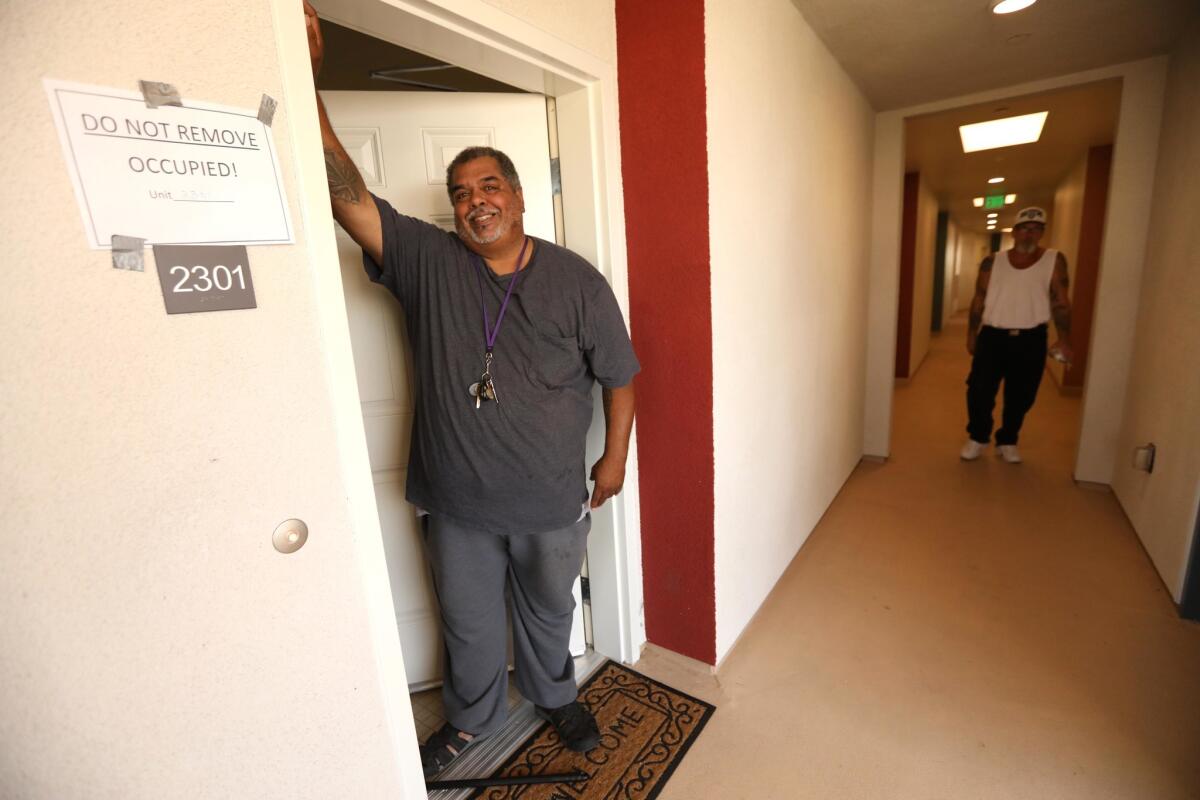Housing units are sitting empty while L.A.’s homeless languish on the streets

- Share via
The effort to house homeless people in the Los Angeles area is beset by many problems — the difficulty finding sites for new housing projects, the resistance from neighbors, the slow pace of construction, the high cost. One thing that shouldn’t be difficult, though, is keeping track of what housing is available for unsheltered people to move into and when it’s available.
Yet it has been a vexing problem. The Los Angeles Homeless Services Authority does maintain a database of the homeless people who get assessed by outreach workers or social workers and then placed into the Homeless Management Information System. That system, which covers most but not all of the county, holds information on people’s backgrounds and needs, and it helps officials decide who should go first into permanent supportive housing.
But after that, the trek for a homeless person from sitting on the street to sitting in an apartment is a long one, due mostly to the shortage of available permanent housing units — but also to an unnecessarily unwieldy bureaucracy.
For starters, LAHSA doesn’t have the wherewithal to compile an inventory of every apartment that might be suitable. Nor is it a reliable source of information about available units. That’s because property managers or landlords don’t always alert LAHSA promptly when a unit becomes vacant (because someone moved out, say, or the tenant died). And even when property managers do alert LAHSA in a timely fashion, there’s the issue of finding the right resident.
Los Angeles Times editorial board endorsements for the U.S. House, California ballot measures and more.
When LAHSA finally knows that a unit is available, it matches a homeless person from its database to the unit, then sends that information to the county Department of Health Services, which alerts a social worker to find the person.
But imagine the difficulty of locating a homeless person whose information was put into the county’s homeless management system months or even years ago. Certainly, social workers who enter people into the system try to stay in touch with those individuals and get them into services and shelter or some other temporary housing. Nonetheless, they’re often dealing with people who live on a sidewalk — and not all of them have cell phones. It can take a social worker a few weeks to find the homeless individual at the top of the list of those eligible for a vacant apartment.
If that person is not located, then LAHSA picks another one and the process starts over. Once a person is located, another time consuming process starts — getting an interview with the property manager, getting the homeless person’s documentation in order, and getting the necessary interview with the local housing authority that validates the information in the housing application. Until recently, in the city of L.A., that interview could take weeks to get, according to LAHSA officials.
The result is that some available housing units sit empty for weeks or even months. That’s ridiculous in a county where homelessness is an emergency. And on the back end, sometimes it takes a while for a landlord to alert LAHSA that a person did move in.
There’s a growing consensus that the Los Angeles Homeless Services Authority needs to be retooled. Yet few can say how or how to make it happen.
So with the help of a consultant from the U.S. Department of Housing and Urban Development, LAHSA officials are revamping the process. They have already set what they’re calling Housing Central Command, with representatives from LAHSA, the county and city housing authorities, Mayor Eric Garcetti’s office, the county Department of Health Services and the county Department of Mental Health. Their goals are to streamline the whole process and create a more complete inventory of housing.
Some changes have already been put in place. For example, when a unit of housing becomes available, LAHSA now submits three names of homeless individuals eligible for the unit to maximize the chances of finding someone quickly. (If all three are located, the two who don’t get the unit are still next in line for available units that match up with their needs.) Officials are also working on streamlining the application process that the housing departments require.
Overhauling the mechanics of getting people housed can be daunting. LAHSA is right to be working on this. It’s bad enough that we don’t have sufficient housing. It’s unforgivable to have such a cumbersome process that it can take weeks to get people into the scarce units that are available. LAHSA needs to fix that now.
That agency also needs to help homeless people move more quickly into temporary housing by setting up a real-time database of shelter beds. Of course, that’s a bigger challenge because the availability of beds changes daily. LAHSA officials say they plan to create the same kind of central command for shelter bed inventory as they’ve done for permanent housing. They need to launch that as soon as they can.
Imagine the difficulty of locating a homeless person whose information was put into the county’s homeless management system months or even years ago.
More to Read
A cure for the common opinion
Get thought-provoking perspectives with our weekly newsletter.
You may occasionally receive promotional content from the Los Angeles Times.











